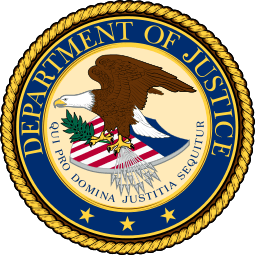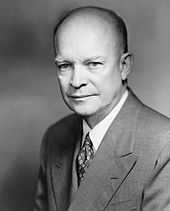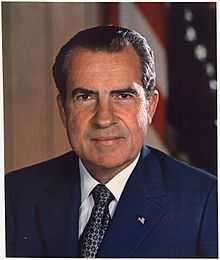William P. Rogers
| William P. Rogers | |
|---|---|
 | |
| 55th United States Secretary of State | |
| In office January 22, 1969 – September 3, 1973 | |
| President | Richard Nixon |
| Preceded by | Dean Rusk |
| Succeeded by | Henry Kissinger |
| 63rd United States Attorney General | |
| In office October 23, 1957 – January 20, 1961 | |
| President | Dwight D. Eisenhower |
| Preceded by | Herbert Brownell, Jr. |
| Succeeded by | Robert F. Kennedy |
| 3rd United States Deputy Attorney General | |
| In office 1953–1957 | |
| President | Dwight D. Eisenhower |
| Preceded by | Ross L. Malone |
| Succeeded by | Lawrence Edward Walsh |
| Personal details | |
| Born | William Pierce Rogers June 23, 1913 Norfolk, New York |
| Died | January 2, 2001 (aged 87) Bethesda, Maryland |
| Resting place | Arlington National Cemetery, Arlington, Virginia |
| Political party | Republican |
| Spouse(s) | Adele Langston Rogers |
| Children | Dale Rogers Marshall Anthony Wood Rogers Jeffrey Langston Rogers Douglas Langston Rogers |
| Alma mater | Colgate University (B.A.) Cornell Law School (J.D.) |
| Profession | Attorney |
| Religion | Presbyterian |
| Signature | |
| Military service | |
| Service/branch | United States Navy |
| Rank | Lieutenant Commander |
| Unit | USS Intrepid |
| Battles/wars | World War II |
William Pierce Rogers (June 23, 1913 – January 2, 2001) was an American politician, who served as a cabinet officer in the administrations of two U.S. presidents in the third quarter of the 20th century.
Early life and education
Rogers was born June 23, 1913, in Norfolk, New York. After the death of his mother, the former Myra Beswick, he was reared during his teen years by his grandparents, in Canton, New York.
He attended Colgate University, where he was initiated into the Sigma Chi fraternity. He then went to Cornell University Law School. He received his law degree and passed the New York Bar in 1937, and he married Adele Langston Rogers (August 15, 1911 – May 27, 2001). The couple had four children, Dale R. Marshall, Douglas L. Rogers, Anthony W. Rogers and Jeffrey L. Rogers.
Early legal career and military service
After serving about a year as an attorney for a Wall Street law office, he became an assistant district attorney in 1938 and was appointed by then District Attorney Thomas E. Dewey to a sixty-man task force aimed at routing out New York City's organized crime.
He entered the United States Navy in 1942, serving on the USS Intrepid, including her action in the Battle of Okinawa. His final rank in the Navy was lieutenant commander.
In 1950, Rogers became a partner in a New York City law firm, Dwight, Royall, Harris, Koegel & Caskey. Thereafter, he returned to this firm when he was not in government service.
While serving as a Committee Counsel to a US Senate committee, he examined the documentation from the House Un-American Activities Committee's investigation of Alger Hiss at the request of Congressman Richard M. Nixon, and advised Nixon that Hiss had lied and that the case against him should be pursued.
Rogers also advised Nixon in the slush fund scandal that led to Nixon's Checkers speech in 1952.
U.S. Deputy Attorney General
Rogers joined the Administration of President Dwight D. Eisenhower as Deputy Attorney General in 1953.
As Deputy Attorney General, Rogers had some role in or insight into the process that led to the execution of Julius and Ethel Rosenberg for espionage.[1]
As deputy attorney general, Rogers was involved in the Little Rock Integration Crisis in the fall of 1957 of Central High School in Little Rock, Arkansas. In that capacity, he worked with Osro Cobb, the United States Attorney for the Eastern District of Arkansas, to implement federal orders and to maintain peace in the capital city. In his memoirs, Cobb recalls that Rogers called him to discuss the possibility of violence. Cobb writes, "Our conversation was somewhat guarded. I had never recommended the use of federal troops, and Rogers asked if I thought they were necessary. I told him I hoped not. Then to my surprise he stated, 'They are on their way already.'"[2]
U.S. Attorney General (1957–1961)
Rogers served as Attorney General from 1957 to 1961. He remained a close advisor to Vice President Nixon throughout the Eisenhower administration, especially during Eisenhower's two medical crises. Rogers became attorney general upon the resignation of his superior, Herbert Brownell, who had worked to implement the desegregation of Little Rock Central High School. In 1958, Little Rock closed its public schools for a year to oppose further desegregation required by the U.S. government. At the time Rogers said that "It seems inconceivable that a state or community would rather close its public schools than comply with decisions of the Supreme Court.[3]
In 1959, Martin Luther King, Jr., hailed Rogers for advocating the integration of an elementary school in Alabama that had excluded the children of black military personnel.[4]
Return to legal career
Now renamed to Rogers & Wells, Rogers returned to his law practice, where he worked until his early 80s. He played an important role in the 1964 New York Times Co. v. Sullivan Supreme Court case.
U.S. Secretary of State (1969–1973)

Preceded by Dean Rusk, Rogers served as United States Secretary of State in the Nixon administration from January 22, 1969, through September 3, 1973. One of his notable works was to initiate efforts at a lasting peace in the Arab–Israeli conflict through the so-called Rogers Plan. Throughout his tenure, however, his influence was drastically circumscribed by Nixon's determination to handle critical foreign policy strategy and execution directly from the White House through his national security adviser, Henry Kissinger.
On October 15, 1973, Rogers received the Presidential Medal of Freedom from President Richard Nixon. At the same ceremony, his wife, Adele Rogers, was presented with the Presidential Citizens Medal.
Later life, death and legacy
Rogers led the investigation into the explosion of the space shuttle Challenger. This panel, called the Rogers Commission, was the first to criticize NASA management for its role in negligence of safety in the Space Shuttle program. Among the more famous members of Rogers' panel were astronauts Neil Armstrong and Sally Ride, Air Force general Donald Kutyna, and physicist Richard Feynman.
Rogers worked at his law firm, now renamed Clifford Chance Rogers & Wells after a 1999 merger, in its Washington office until several months before his death.
He died of congestive heart failure, at the Suburban Hospital in Bethesda, Maryland on January 2, 2001, at the age of 87. Rogers was buried in Arlington National Cemetery. At the time of his death, he was the last surviving member of the Eisenhower Administration.[5]
In 2001, the Rogers family donated to Cornell Law Library that reflect the lives of William and Adele Rogers, the majority of items from the years 1969–1973.[6]
His son, Jeffrey Langston Rogers, served as City Attorney for Portland, Oregon, from 1985 to 2004.
Sources
Notes
- ↑ Roberts, Sam (June 26, 2008). "Spies and Secrecy". New York Times. Retrieved 2008-06-27.
Shortly before he died, I interviewed William Rogers. He was the deputy attorney general when the Rosenbergs were executed. I guess, I said to him, the government got what it wanted: the Rosenbergs were indicted, convicted and executed. No, he replied, the goal wasn’t to kill the couple. The strategy was to leverage the death sentence imposed on Ethel to wring a full confession from Julius — in hopes that Ethel’s motherly instincts would trump unconditional loyalty to a noble but discredited cause.
- ↑ Osro Cobb, Osro Cobb of Arkansas: Memoirs of Historical Significance, Carol Griffee,ed. (Little Rock, Arkansas: Rose Publishing Company), (1989), p. 234
- ↑ Osro Cobb, pp. 267–268
- ↑ Martin Luther King, Jr (November 19, 1959). "To William P. Rogers" (PDF). Stanford University.
- ↑ Stout, David (January 4, 2001). "William P. Rogers, Who Served as Nixon's Secretary of State, Is Dead at 87". New York Times. Retrieved 2008-12-25.
William P. Rogers, a suave and well-connected Republican lawyer who was secretary of state under President Richard M. Nixon and attorney general in the Eisenhower administration, died on Tuesday in Bethesda, Md. He was 87. Mr. Rogers lived in Bethesda and worked in the Washington office of the law firm of Clifford Chance Rogers & Wells, where he was senior partner, until becoming ill several months ago. He suffered from congestive heart failure, his family said.
- ↑ http://library.lawschool.cornell.edu/WhatWeHave/SpecialCollections/Rogers.cfm materials
| Wikimedia Commons has media related to William P. Rogers. |
External links
- Papers of William P. Rogers, Dwight D. Eisenhower Presidential Library
- Finding aid for the William P. Rogers Oral History, Dwight D. Eisenhower Presidential Library
| Legal offices | ||
|---|---|---|
| Preceded by A. Devitt Vanech |
U.S. Deputy Attorney General Served under: Dwight D. Eisenhower 1953–1957 |
Succeeded by Lawrence E. Walsh |
| Preceded by Herbert Brownell, Jr. |
U.S. Attorney General Served under: Dwight D. Eisenhower 1957–1961 |
Succeeded by Robert F. Kennedy |
| Political offices | ||
| Preceded by Dean Rusk |
U.S. Secretary of State Served under: Richard Nixon 1969–1973 |
Succeeded by Henry Kissinger |
| ||||||||||||
| ||||||||||||||||||||||||||||||||||||||||||||||||
| ||||||||||||||||||||||||||||||||||||||||||||||||||||||||
|



